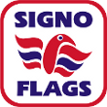The flag is piece of textile defined by its shape, side ration and colourful pattern.
Vexillology uses the following terms for the description of the flag:
-
Field or list – basic area or basic colour of the background
-
Emblem – whatever pattern placed on the list or added to the basic pattern of the flag
-
Canton – this term is always used for marking upper edge of the flag in the shafts edge
-
Shaft part – part of the flag which is placed as furthest to the shaft, the erected rope goes through this part
-
Flying part – flip side to the shaft part, part which is flying

The emblem of the flag is mostly the coat of arms. The study of the coat of arms, its development, appearance and the right usage is called heraldry. It uses four basic colours. Red, blue, black and green are combined with the golden ( yellow) and silver ( white) ones. They are together called as tinctures. The first most important badge is in the middle of the coat of arms. The second one from the view of the observer is in the left side from the first and the third on the right from the first. In this way are arranged not only coat of arms, but also flags, signatures and stages of the victors and etc.
In the description of the coat of arms are used following terms according to the heraldry:
-
Crown – component, which is placed on the top of the pattern above the shield
-
Wreath – colourful rope above the helmet and the shield
-
Ornamental drapery – the stripes of the cloth hanging or flying from the wreath
-
Shield – the basic element, the coat of arms is displayed on it
-
Shield bearer – human or animal figures, which support the shield
-
Basement – the base, the shield is placed on it
-
Ribbon – strip, which is usually placed bellow the shield and the motto is written on it

